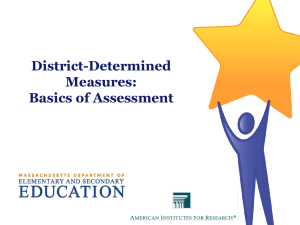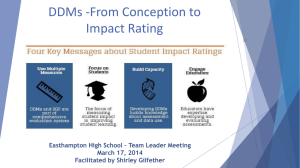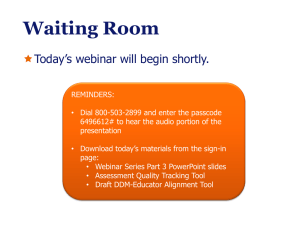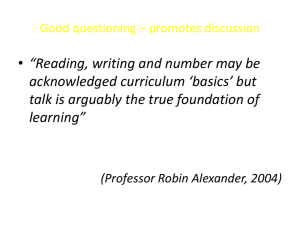DDM Webinar Part 2 - Massachusetts Department of Education
advertisement
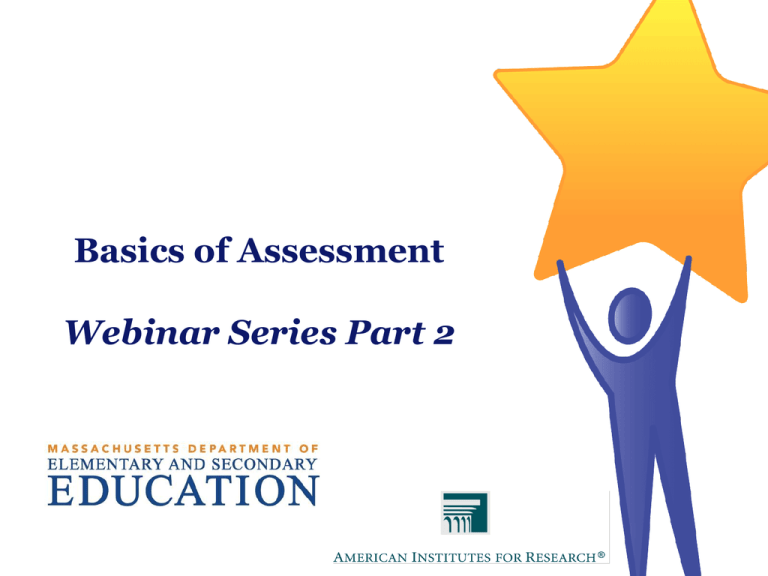
Basics of Assessment Webinar Series Part 2 Logistics Q&A Type your questions into the Chat box on the lower right-hand corner of the screen Recording Each part of the webinar series will be recorded and archived. Supplemental materials All materials needed to participate in each session will be posted on the sign-in page. 2 Webinar Series Title Date Length Time 1 Introduction: District-Determined Measures and Assessment Literacy 3/14 60 minutes 4-5pm ET 2 Basics of Assessment 4/4 90 minutes 4-5:30pm ET 3 Assessment Options 4/25 60 minutes 4-5pm ET TA and Networking Session I 5/23 7/18 60 minutes 4-5pm ET 8/15 60 minutes 4-5pm ET 8/29 60 minutes 4-5pm ET 4 5 6 Determining the Best Approach to DistrictDetermined Measures Integrating Assessments into Educator Evaluation: Reporting Student Growth Integrating Assessments into Educator Evaluation: Developing Business Rules and Engaging Staff TA and Networking Session II 9/19 7 Communicating results 10/24 60 minutes 4-5pm ET 8 Sustainability 12/5 60 minutes 4-5pm ET TA and Networking Session III 12/12 Audience & Purpose Target audience District teams that will be engaged in the work of identifying and selecting District-Determined Measures Purpose Participants will: develop a working knowledge of the key concepts of assessment relevant for using assessments to measure student growth learn about different types of assessments, how to determine assessment alignment, and elements of assessment quality 4 Agenda District Determined Measures Assessment Overview Types of Assessments Alignment Assessment Components Assessment Quality 5 District Determined Measures Measures of student learning, growth, and achievement related to the Massachusetts Curriculum Frameworks, Massachusetts Vocational Technical Education Frameworks, or other relevant frameworks, that are comparable across grade or subject level district-wide. Pre and post unit and course assessments Approved commercial assessments Portfolios Capstone projects 6 Student Impact Rating Student Impact Rating must be based on at least 2 years of data (trends) across multiple measures (patterns): State-wide growth measures MCAS student growth percentiles District-Determined Measures Year Year 1 Year 2 Measure MCAS SGP, grade 5 mathematics Unit assessment on multiplication and division of fractions MCAS SGP, grade 5 mathematics Unit assessment on multiplication and division of fractions Part VII: Rating Educator Impact on Student Learning Using District-Determined Measures of Student Learning 7 The Opportunity Identifying DDMs can be the impetus for broadening and strengthening the district’s assessment practices. DDMs will provide educators with useful data that will help them improve both student outcomes and their instructional practices. DDMs will yield data educators can use throughout the 5-step evaluation cycle. 8 Agenda District-Determined Measures Assessment Overview Types of Assessments Alignment and Rigor Assessment Components Assessment Quality 9 Assessment Overview Assessment is a general term that refers to the process of gaining information about student learning Process includes administration procedures, scoring, reporting, etc. A DDM is an assessment Instrument refers to a specific type of data collection tool or mechanism used in an assessment process There are many types of instruments A test is one example 10 Value of Good Assessment Better teaching Better learning and greater confidence Better student outcomes Better opportunities in life Better assessment 11 Assessment Approaches Indirect Gather information from sources other than actual samples of student work Direct Gather information from actual samples of student work 12 Agenda District-Determined Measures Assessment Overview Types of Assessments Alignment and Rigor Assessment Components Assessment Quality 13 Types of Assessments On-Demand Performance, Project Summative Assessments: EOC, EOY, Interim, Capstone Portfolio Hybrid 14 On-Demand Assessments An assessment that takes place at a predetermined time and place, usually under standard conditions for all students being assessed E.g., SAT, district and state tests, and most in-class unit tests and final exams 15 Performance/Project Assessments based on observations of behaviors or based on work performed on a complex activity Natural vs. Artificial Unstructured vs. Structured Participant vs. External Observer Self-rated vs. Other-rated (teacher, peer, observer) 16 Portfolio A purposeful and systematic collection of student work Should include: student participation in the selection of portfolio content, the criteria for selection are aligned to standards and gradelevel expectations through a rubric or other scoring device, the criteria for judging merit, and evidence of student self-reflection May include both finished work (Product) and work in progress (Process) When using portfolios for DDMs, include the student’s finished products whenever possible May focus on one or more curricular areas 17 Hybrid Assessment An on-demand assessment that combines of two or more types of assessments Usually a paper-and-pencil or online test with a performance, portfolio, or project assessment 18 Reflection #1 Take a minute to jot down sources of existing assessments that might be used for DDMs. 19 Agenda District-Determined Measures Assessment Overview Types of Assessments Alignment and Rigor Assessment Components Assessment Quality 20 Alignment and Rigor Alignment refers to the extent to which the assessment aligns with curriculum as expressed in the curriculum map Rigor is the level of cognitive complexity of the item or of a set of items Bloom’s revised taxonomy or other taxonomy Understanding alignment and rigor is critical for selecting or developing an assessment Documentation is the key! E.g., Table of Test Specifications 21 Alignment DDMs reflect key learning objectives by grade and content area Information on key objectives is found in the district’s curricular maps and other curricular planning tools 22 Alignment Identify the key content you want to assess Standards E.g., Use trigonometric ratios and the Pythagorean Theorem to solve right triangles in applied problems (Mathematics.G.SRT.3.08) Learning objectives E.g., Students will correctly apply Pythagorean Theorem when prompted. E.g., Students determine when to correctly apply trigonometric ratio models. 23 Table of Test Specifications Grade 10 Mid-Unit Math Test Cognitive Complexity Mathematics.G.SRT.3.08 LO #1: Students will correctly apply Pythagorean Theorem when prompted. LO: #2 Students determine when to correctly apply trigonometric ratio models. SubTotal LowerOrder HigherOrder Subtotal 25% 30% 55% 25% 20% 45% 24 50% 50% 100% Rigor – Revised Bloom’s Taxonomy 25 Rigor – Revised Bloom’s Taxonomy 26 Rigor – Revised Bloom’s Taxonomy 27 Reflection #2 Think about the potential DDMs you wrote down in Reflection #1. Of these, consider which one shows the best alignment to the curriculum and the degree of rigor. Identify one that is promising but that does not show perfect alignment. Consider how could it be improved. 28 Agenda District-Determined Measures Assessment Overview Types of Assessments Alignment and Rigor Assessment Components Assessment Quality 29 Assessment Components Table of Test Specifications Administration Protocol Instrument Scoring Method Documentation 30 Administration Protocols Often found in Administration Manuals Needed to ensure all students have a fair opportunity to demonstrate what they know and can do in the assessment Proctoring directions All examinees receive same set of directions and conditions for taking the instrument (including resources – e.g., calculator – breaks, pacing, etc.) Security provisions Ensure specific items are not overly familiar to examinees and proctors (unless portfolio assessment is used) Student accommodations Ensure the majority of students can participate in the program, with appropriate supports 31 Items Selected Response True–False Multiple Choice Matching Constructed Response Short answer Restricted constructed response Extended constructed response (includes essay) Portfolio item Performance item 32 Selected Response Item 33 Constructed Response Item MCAS Test Question Grade 8 2012 Question 10 34 Scoring Items Scoring objective items Scoring key or short guide Based on clearly defined scoring key and set of scoring rules Limits error variance Scoring subjective items Longer scoring guide with rubrics or calibrated scoring papers Based on personal judgment Increases potential for error 35 Sample Holistic Rubric In 200 words or less, describe how you would explain to a home owner the concept of eminent domain and how it is related to the Fifth Amendment. Sample Analytic Rubric MCAS Test Question Grade 8 2012 Question 10 Calibrated Scoring Paper 38 MCAS Test Question Grade 8 2012 Question 10 Reporting, Interpretation and Use Reports provide information and conclusions from and based on the assessments May provide information in the form of text, graphs, images, etc… A goal of any assessment is to yield information that will help educators make appropriate decisions or driving meaningful change Assessments are most useful when reports tied to objectives and are easy to understand and use 39 Simple Score Report 40 Documentation Technical Manual Administration Manual 41 Reflection #3 In summary, assessments are composed of: Table of Test Specifications Administration Protocol Instrument Scoring Method Documentation Reflect for a moment on one of the assessments you’re considering for use as a DDM. Identify the components you have in place and those you’d want to develop. 42 Agenda District-Determined Measures Assessment Overview Types of Assessments Alignment and Rigor Assessment Components Assessment Quality 43 Assessment Quality Reliability Validity Fairness and Non-Bias Item Quality Feasibility 44 Reliability Degree of consistency in measurement We want to have confidence that scores are stable Example: Weighing yourself on a scale 45 Reliability Four typical approaches Internal consistency Test-retest Alternate forms or split-half Inter-rater agreement Reliability coefficients are estimated using statistical formulas We cannot “see” reliability Ranges from 0 (no reliability) to 1 (perfect reliability) 46 Validity Validity refers to the validity of inferences made about assessments or based on assessment data Gives you confidence that what you say about student assessment scores and therefore about students is justified Example: Weighing yourself on two different kinds of scales 47 Validity Based on Content For existing measures, districts review content in instrument and judge whether it matches curriculum (review of alignment and rigor) 48 Validity Based on Relationships Assessment should show: Moderate to strong and positive correlations with similar instruments/outcomes Low positive or even negative correlations with dissimilar instruments/outcomes Correlation = A statistical technique that is used to measure and describe the strength and direction of the relationship between two variables Range from -1 to +1 49 Consequential Validity Realization of benefits Student learning Teacher improvement Minimization of negative consequences Poor student or teacher attitudes toward the assessment or assessments generally Limiting instruction only to the content covered in the instrument Improper use of scores 50 Fairness and Non-Bias Fairness All examinees have equal opportunity to demonstrate knowledge on assessment Non-Bias Students with similar ability receive similar scores, regardless of group membership 51 Item Quality Item quality is a key to assessment quality We typically look at three things: Difficulty Ensure a range of difficulty (e.g., easy, medium, hard) in items Average difficulty aligns to assessment purpose and target population Discrimination Ensure that people who got higher scores on the instrument overall tend to get higher scores on that item Guessing Reduce guessing by writing good response options for selected response items (e.g., multiple-choice items) 52 Feasibility Cost Technology E.g., Paper and pencil, online, adaptive Assessment length Reports E.g., access to, ability to interpret Accommodations and accessibility 53 Reflection #4 Based on all that we discussed today, identify some basic “do’s and don’ts” about assessment that you need to consider when selecting or building a DDM. 54 Resources Association of Test Publishers http://www.testpublishers.org/ Buros Mental Measurements Yearbook and Tests in Print http://buros.org/mental-measurements-yearbook http://buros.org/tests-print APA, NCME, and AERA Standards for Educational and Psychological Testing http://www.apa.org/science/programs/testing/standards .aspx National Council on Assessment in Education http://ncme.org/ 55 Register for Webinar 3 Assessment Options April 25th from 4:00 PM – 5:00 PM Identify one or more potential DDMs, create a map of assessment gaps appropriate for accountability purposes, develop a preliminary action plan to bring to the Technical Assistance and Networking Session Click here to register: https://air- event500.webex.com/airevent500/onstage/g.php?d=590644030&t=a 56 Questions Contact Ron Noble at rnoble@doe.mass.edu Feedback Tell us how we did: http://www.surveygizmo.com/s3/1209968/Dist rict-Determined-Measures-amp-AssessmentLiteracy-Webinar-2-Feedback 57
